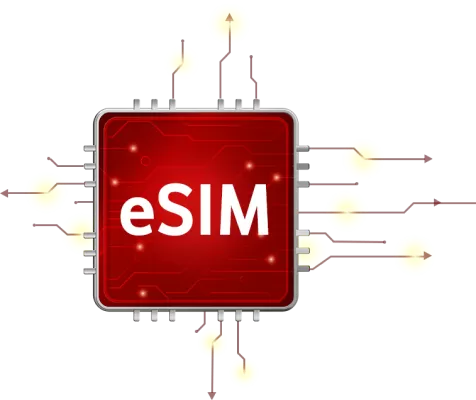
How eSIM is Disrupting the Telecommunications Market
In recent years, eSIM technology has been at the forefront of a digital revolution, significantly impacting the telecommunications industry. As an embedded SIM that allows users to activate a mobile plan without the need for a physical SIM card, eSIM is ushering in new levels of convenience, flexibility, and functionality. This transformation is particularly relevant in an era of increasing digital consumption and global connectivity. eSIM telecommunications market
Let’s explore the key ways eSIM is disrupting the traditional telecommunications market.
1. Eliminating the Need for Physical SIM Cards
The most visible change eSIM technology brings is the elimination of the traditional physical SIM card. This shift not only saves space inside mobile devices, allowing manufacturers to create slimmer and more efficient designs, but it also removes logistical challenges for carriers. Users no longer need to visit physical stores to get a SIM card or wait for it to arrive via mail. eSIM can be activated remotely through digital means, streamlining the customer experience and saving valuable time.
2. Simplifying Global Connectivity
For frequent travelers, eSIM is a game-changer. Traditional SIM cards come with the hassle of swapping between different operators and paying costly roaming fees. eSIM allows users to switch between mobile operators and data plans seamlessly across borders, without needing to change physical SIMs. This flexibility is particularly appealing to international business travelers and digital nomads, helping to drive demand for eSIM-enabled devices and services globally.
3. Enabling Device Flexibility and Multi-Network Access
With eSIM, consumers can easily switch between network operators without being tied down by long-term contracts or the need to physically replace their SIM card. This flexibility makes it easier for consumers to compare and choose better plans without incurring switching costs. For telecom operators, this shift increases competition but also opens up new opportunities to offer more competitive and innovative service packages. In addition, eSIMs allow devices to connect to multiple networks at once, making them ideal for IoT devices that need constant and reliable connectivity.
 4. Driving the Growth of IoT and Wearable Devices
4. Driving the Growth of IoT and Wearable Devices
eSIM is playing a crucial role in the expansion of the Internet of Things (IoT). As more devices, from smartwatches to connected cars, rely on cellular connectivity, eSIM enables seamless communication without the need for traditional SIM cards. IoT manufacturers benefit from this by reducing the complexity of the supply chain and product design. Consumers benefit from more compact and energy-efficient devices that can connect to cellular networks anywhere in the world without hassle. The adoption of eSIM is accelerating innovation in wearables, health monitors, and industrial applications, driving growth in this sector.
5. Creating New Challenges and Opportunities for Telecom Operators
While eSIM opens up new opportunities, it also presents challenges for traditional telecom operators. The ability for consumers to switch between networks easily increases customer churn, putting pressure on telecom providers to innovate and retain customers. However, it also encourages operators to develop new service models, such as offering global plans that cater to international travelers, IoT services, or premium packages that bundle various services. In addition, operators can use eSIM technology to target new markets and niches by offering flexible, on-demand data plans for short-term users or seasonal travelers.
6. Transforming Mobile Device Ecosystem
eSIM is also driving changes within the mobile device ecosystem. Manufacturers are increasingly adopting eSIM across their product lines, from smartphones to tablets and laptops. Apple’s introduction of the iPhone with eSIM support and other leading smartphone brands following suit has created momentum for the technology. As more devices become eSIM-enabled, the telecommunications landscape will continue to evolve, fostering new opportunities for device manufacturers, carriers, and consumers alike.
Conclusion eSIM telecommunications market
eSIM technology is undeniably reshaping the telecommunications market, offering consumers greater flexibility and convenience while driving competition among carriers. As eSIM adoption grows, it will also continue to fuel the rise of IoT devices and expand global connectivity. While telecom operators may face challenges from increased customer churn, those who embrace this shift will find opportunities to innovate and thrive in this dynamic market.
- AIRALO
-
eSIM for
Europe
39 countries
-
1 GB – 7 days – €4.27
3 GB – 30 days – €11.09
10 GB – 30 days – €31.57
- AIRHUB
-
eSIM for
Europe
34 countries
-
1 GB – 7 days – €2.99
3 GB – 30 days – €5.12
10 GB – 30 days – €11-09
- aloSIM
-
eSIM for
Europe
32 countries
-
1 GB – 7 days – €5.00
3 GB – 30 days – €13.00
10 GB – 30 days- €36.00
- GigSky
-
eSIM for
Europe
36 countries
-
1 GB – 7 days – €6.99
3 GB – 15 days – €11.19
10 GB – 30 days – €27.99
- iRoamly
-
eSIM for
Europe
39 countries
-
1 GB – 7 day – €6.83
3 GB – 15 days – €10.24
10 GB – 30 days – €18.77
- Maya Mobile
-
eSIM for
Europe
34 countries
-
1 GB – 7 days – –
5 GB – 15 days – €5.99
10 GB – 30 days- €13.99
- NOMAD
-
eSIM for
Europe
36 countries
-
1 GB – 7 days – €4.71
3 GB – 15 days – €10.27
10 GB – 30 days – €15.41
- UBIGI
-
eSIM for
Europe
29 countries
-
500 MB – 1 day – €2.00
3 GB – 30 days – €8.00
10 GB – 30 days – €19.00
- VOIA
-
eSIM for
Europe
34 countries
-
1 GB – 7 days – €2.69
3 GB – 15 days – €5.05
10 GB – 30 days- €11.70





 4. Driving the Growth of IoT and Wearable Devices
4. Driving the Growth of IoT and Wearable Devices












